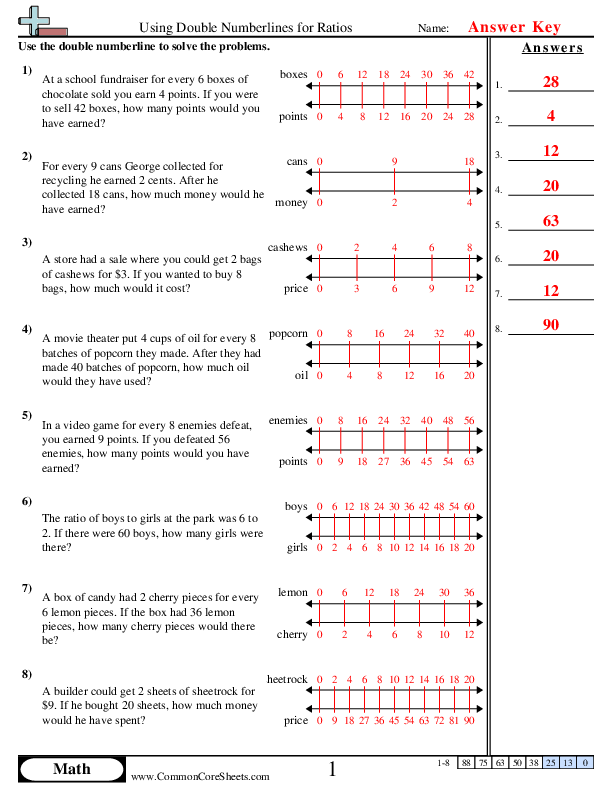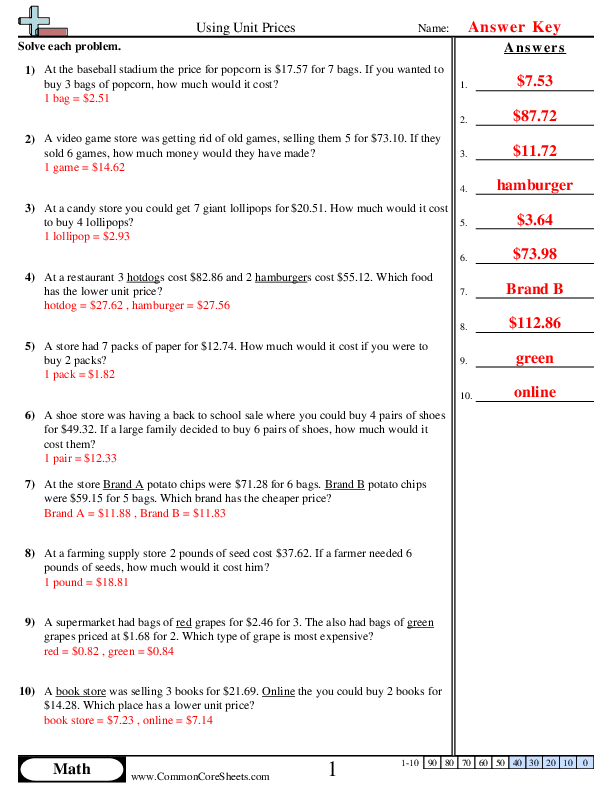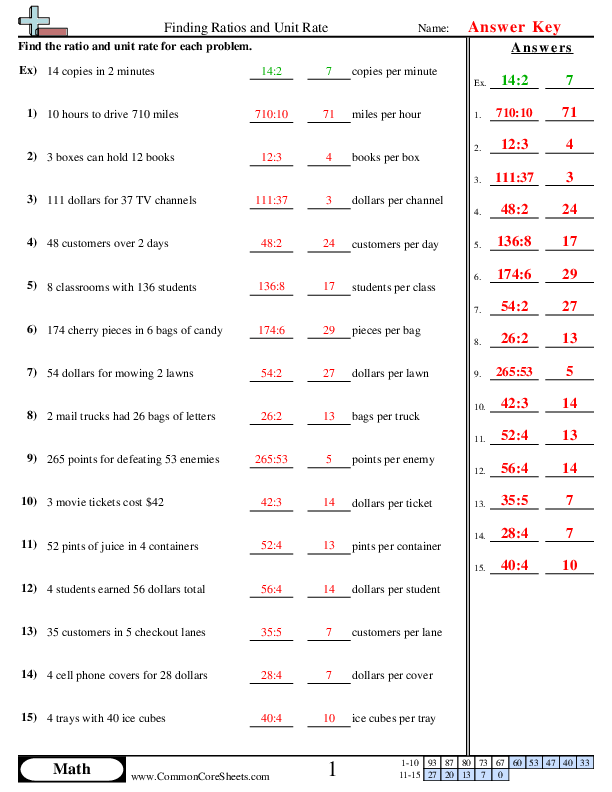Sort By Grade
Ratios and Proportional Relationships
Understand ratio concepts and use ratio reasoning to solve problems.
3Use ratio and rate reasoning to solve real-world and mathematical problems, e.g., by reasoning about tables of equivalent ratios, tape diagrams, double number line diagrams, or equations.
bSolve unit rate problems including those involving unit pricing and constant speed. For example, if it took 7 hours to mow 4 lawns, then at that rate, how many lawns could be mowed in 35 hours? At what rate were lawns being mowed?
6rp3b
Ratios and Unit Rates
6rp3b


×
Description:
"This worksheet is designed to teach children about the concept of ratios and unit rates in math. It contains 15 problems involving various contexts such as classrooms, CDs, game points, eating speed, ticket prices, earnings, snowfall, juice containers, TV commercials, and candy bags. Ideal for distance learning, its interactive format is customizable and can easily be converted into flash cards for convenient learning."

×
Student Goals:

Ratios Double Line
6rp3b


×
Description:
"This worksheet is designed to help children grasp the concept of ratios using double numberlines effectively. With real-world situations contextualized in 8 unique math problems, learners can deepen their understanding, and further apply this skill. The flexible format allows customization, conversion to flash cards, or use in distance learning, catering to various learning styles and environments."

×
Student Goals:
Understanding of RatiosAfter completing the worksheet, students will have a solid understanding of ratios. They will be able to interpret and apply the concept of ratios in a variety of real-life situations like proportions of ingredients in a recipe or pricing of items in bulk. This foundational knowledge is critical in many aspects of numeracy and is often applied in higher-level mathematics.Problem-Solving AbilitiesThis worksheet aids in honing students' problem-solving abilities. Each problem tasks students with calculating quantities based on given ratios, which requires both critical thinking and arithmetical skills. By working through these problems, students will become more proficient at approaching and solving mathematical challenges.Application of Number Line ConceptWith the completion of the worksheet, students will be adept at using number lines as a visual aid in the understanding of ratios. They will be able to associate the concept of ratios with the practical visual model of a number line, helping them to better understand and solve problems involving ratios.Master of Multiplication and DivisionAs students engage with this worksheet they will practice essential mathematical operations, particularly multiplication and division. This is due to the nature of processing proportions and ratios. Regular engagement in these operations will help students become proficient and increase their speed in mathematical computations.Conceptual Understanding of Proportional RelationshipsProportional relationships are a key aspect of this worksheet. After completion, students will be able to identify and understand these relations in various settings. They will be able to relate real-life situations to corresponding mathematical expressions, ratios, or equations, consolidating their understanding of these abstract concepts.Enhanced Mathematical LiteracyLast but not least, upon successful completion of the worksheet, students will gain significant strides in widening their mathematical literacy. This involves not just the ability to solve problems, but also a comprehension of why the solutions work. Hence, they can apply this knowledge to tackle similar problems in the future, thereby making them more mathematically autonomous and confident learners.



Using Unit Prices
6rp3b


×
Description:
"This worksheet is designed to enhance children's understanding of math through practical application, focusing on the concept of unit prices. It presents ten problems involving comparative shopping and budgeting scenarios, encouraging critical thinking and basic arithmetic skills. The worksheet can be customized for individual learning pace, converted into flash cards for interactive learning or employed in distance learning settings to suit unique educational needs."

×
Student Goals:
Understanding Unit PricesUpon completion of the worksheet, students should have a well-rounded understanding of unit prices. They will have confronted various real-life scenarios involving different items and quantities which will assist them in comprehending how the concept of unit price operates in everyday life. Students will be able to apply those concepts to new, similar situations they encounter.Comparative Shopping SkillsStudents will learn how to compare the prices of different brands or vendors of a given product in a market or store. They will gain the ability to decide which option provides the best value for money, enhancing their economic and financial awareness. This skill will be useful for efficient shopping and expenditure management in the future.Mathematical ProficiencyThe worksheet will enhance students' mathematical proficiency, specifically in operations involving division to determine unit prices. They will become more comfortable performing these operations and interpreting the results, strengthening their overall mathematical abilities and confidence.Decision-Making SkillsThe practice of deciding the better deal between different products or brands based on their unit prices encourages critical thinking and decision-making skills. This will assist students in making informed decisions, not only in a shopping context but also in other aspects of life that require similar analytical skills.Problem-Solving SkillsBy applying their knowledge of unit prices to real-world problems, students will develop essential problem-solving skills. These skills are not only applicable to mathematics but also other areas of life where they need to deduce solutions from given facts or conditions.Practical Transferable SkillsCompleting this worksheet will offer students practical, transferable skills. The ability to calculate and understand unit prices is useful both within and outside of a school context, equipping students with valuable tools they can use in their daily lives and in future careers.




